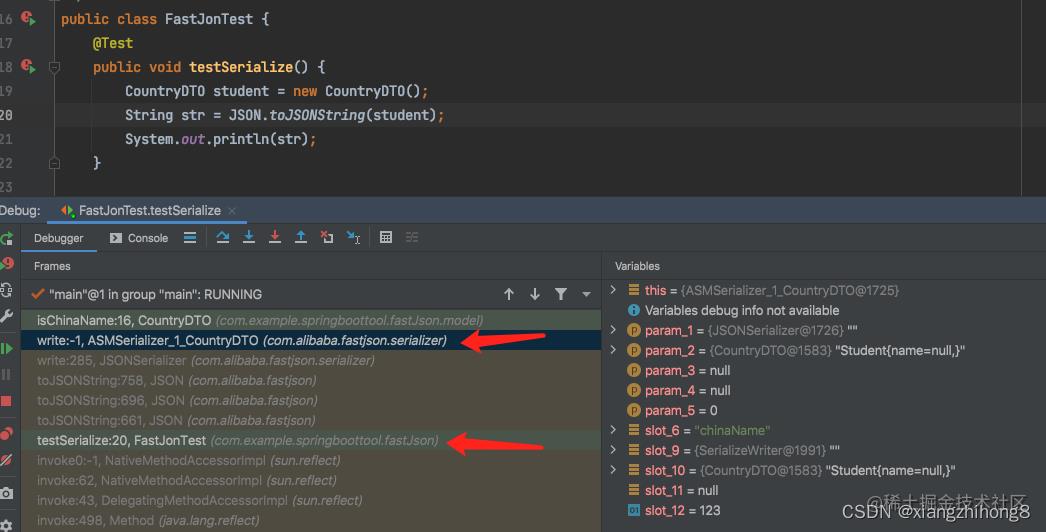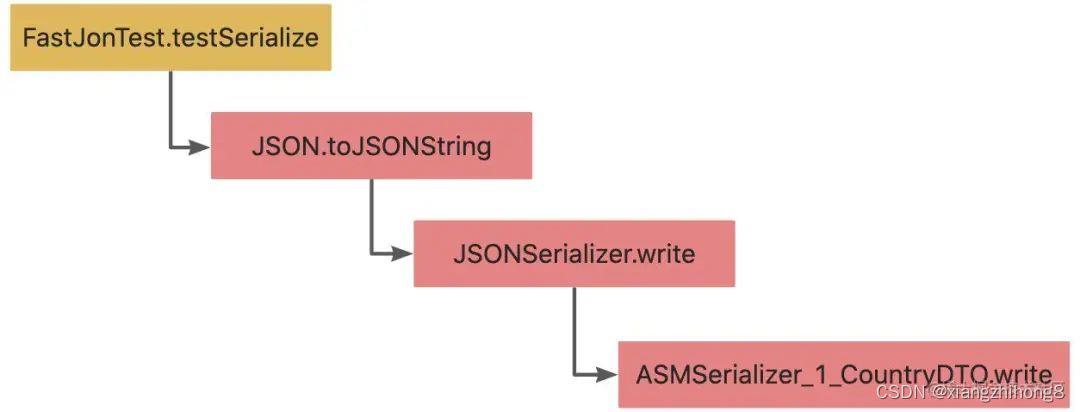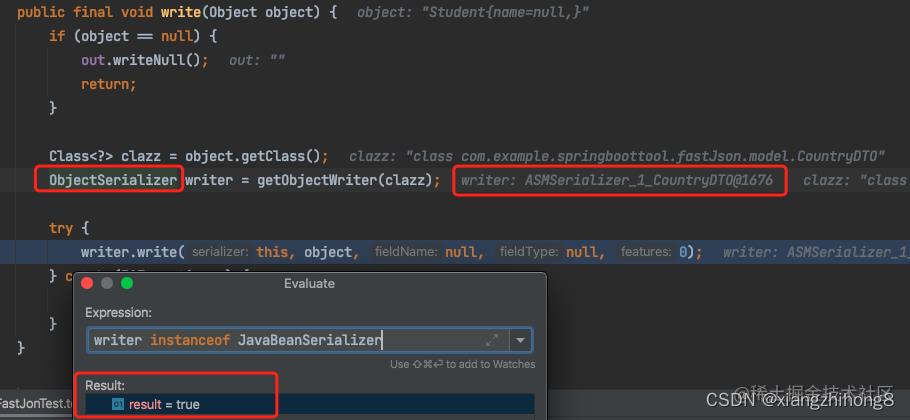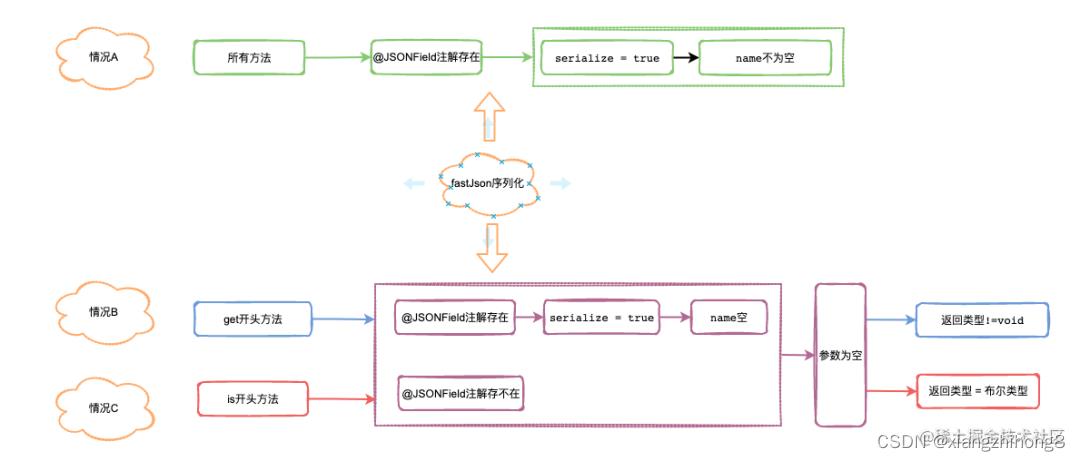因为一行Log日志导致的线上P1事故
Posted xiangzhihong8
tags:
篇首语:本文由小常识网(cha138.com)小编为大家整理,主要介绍了因为一行Log日志导致的线上P1事故相关的知识,希望对你有一定的参考价值。
前段时间,同事新增了一个特别简单的功能,晚上上线前review代码时想到公司拼搏进取的价值观临时他加一行 Log 日志,觉得就一行简单的日志基本上没啥问题,结果刚上完线后一堆报警,赶紧回滚了代码,找到问题然后删除添加日志的代码,重新上线完毕。之前网上看过这种消息,没想到自己却遇到了。
情景还原
定义一个 CountryDTO:
public class CountryDTO
private String country;
public void setCountry(String country)
this.country = country;
public String getCountry()
return this.country;
public Boolean isChinaName()
return this.country.equals("中国");
定义测试类 FastJonTest:
public class FastJonTest
@Test
public void testSerialize()
CountryDTO countryDTO = new CountryDTO();
String str = JSON.toJSONString(countryDTO);
System.out.println(str);
运行时就报了一个空指针错误。

通过报错信息可以看出来是序列化的过程中执行了isChinaName()方法,这时候this.country变量为空,那么问题来了:
- 序列化为什么会执行isChinaName()呢?
- 引申一下,序列化过程中会执行那些方法呢?
源码分析
首先,我们通过Debug 来观察调用链路的堆栈信息。


调用链中的ASMSerializer_1_CountryDTO.write是FastJson使用asm技术动态生成了一个类ASMSerializer_1_CountryDTO。asm技术其中一项使用场景就是通过到动态生成类用来代替java反射,从而避免重复执行时的反射开销
JavaBeanSerizlier序列化原理
通过下图看出序列化的过程中,主要是调用JavaBeanSerializer类的write()方法。

而JavaBeanSerializer主要是通过getObjectWriter()方法获取,通过对getObjectWriter()执行过程的调试,找到比较关键的com.alibaba.fastjson.serializer.SerializeConfig#createJavaBeanSerializer方法,进而找到 com.alibaba.fastjson.util.TypeUtils#computeGetters。
public static List<FieldInfo> computeGetters(Class<?> clazz, //
JSONType jsonType, //
Map<String,String> aliasMap, //
Map<String,Field> fieldCacheMap, //
boolean sorted, //
PropertyNamingStrategy propertyNamingStrategy //
)
//省略部分代码....
Method[] methods = clazz.getMethods();
for(Method method : methods)
//省略部分代码...
if(method.getReturnType().equals(Void.TYPE))
continue;
if(method.getParameterTypes().length != 0)
continue;
//省略部分代码...
JSONField annotation = TypeUtils.getAnnotation(method, JSONField.class);
//省略部分代码...
if(annotation != null)
if(!annotation.serialize())
continue;
if(annotation.name().length() != 0)
//省略部分代码...
if(methodName.startsWith("get"))
//省略部分代码...
if(methodName.startsWith("is"))
//省略部分代码...
从代码中可以看出,大致分为三种情况:
- @JSONField(.serialize = false, name = “xxx”)注解
- getXxx() : get开头的方法
- isXxx():is开头的方法
序列化流程图

下面是一段示例代码:
@JSONType(ignores = "otherName")
public class CountryDTO
private String country;
public void setCountry(String country)
this.country = country;
public String getCountry()
return this.country;
public static void queryCountryList()
System.out.println("queryCountryList()执行!!");
public Boolean isChinaName()
System.out.println("isChinaName()执行!!");
return true;
public String getEnglishName()
System.out.println("getEnglishName()执行!!");
return "lucy";
public String getOtherName()
System.out.println("getOtherName()执行!!");
return "lucy";
/**
* case1: @JSONField(serialize = false)
*/
@JSONField(serialize = false)
public String getEnglishName2()
System.out.println("getEnglishName2()执行!!");
return "lucy";
/**
* case2: getXxx()返回值为void
*/
public void getEnglishName3()
System.out.println("getEnglishName3()执行!!");
/**
* case3: isXxx()返回值不等于布尔类型
*/
public String isChinaName2()
System.out.println("isChinaName2()执行!!");
return "isChinaName2";
运行结果为:
isChinaName()执行!!
getEnglishName()执行!!
"chinaName":true,"englishName":"lucy"
代码规范
可以看出来序列化的规则还是很多的,比如有时需要关注返回值,有时需要关注参数个数,有时需要关注@JSONType注解,有时需要关注@JSONField注解;当一个事物的判别方式有多种的时候,由于团队人员掌握知识点的程度不一样,这个方差很容易导致代码问题,所以尽量有一种推荐方案。
这里推荐使用@JSONField(serialize = false)来显式的标注方法不参与序列化,下面是使用@JSONField注解后的代码,是不是一眼就能看出来哪些方法不需要参与序列化了。
public class CountryDTO
private String country;
public void setCountry(String country)
this.country = country;
public String getCountry()
return this.country;
@JSONField(serialize = false)
public static void queryCountryList()
System.out.println("queryCountryList()执行!!");
public Boolean isChinaName()
System.out.println("isChinaName()执行!!");
return true;
public String getEnglishName()
System.out.println("getEnglishName()执行!!");
return "lucy";
@JSONField(serialize = false)
public String getOtherName()
System.out.println("getOtherName()执行!!");
return "lucy";
@JSONField(serialize = false)
public String getEnglishName2()
System.out.println("getEnglishName2()执行!!");
return "lucy";
@JSONField(serialize = false)
public void getEnglishName3()
System.out.println("getEnglishName3()执行!!");
@JSONField(serialize = false)
public String isChinaName2()
System.out.println("isChinaName2()执行!!");
return "isChinaName2";
三个频率高的序列化场景

以上流程基本遵循,发现问题 --> 原理分析 --> 解决问题 --> 升华。但其实这段代码我并不满意,原因是和 FastJson 依赖太高了。我想要的效果是,不依赖任何特定的 JSON 序列化框架。当我需要替换掉它的时候,随时可以替换掉。
并且在写代码时,不要过于依赖日志。打日志只需要打紧要且关键的信息即可,不要什么日志都打,我曾见过一个系统,一个小时,把 128G 磁盘跑满的管理系统。几乎没啥并发,但几乎每个请求都输出几 M 的日志,这件事我后面会单独拿出来讲讲。
关于@JSONField和@JSONType等特性注解,后面我会在团队内规范并给出新的解耦方案,把它们移除掉。
以上是关于因为一行Log日志导致的线上P1事故的主要内容,如果未能解决你的问题,请参考以下文章